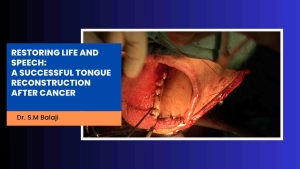Patient with residual facial deformity from old RTA correction surgery
The patient is a young man who had suffered a zygomatico orbital fracture from a road accident. He had also suffered a depressed supraorbital bone fracture over his left orbit. This had happened in his hometown two years ago. He had undergone emergent surgery at a local hospital. This surgery had left him with an asymmetric face and chronic diplopia. The chronic diplopia was the result of an orbital floor fracture that had not been set right. This had been a source of trouble for him for the last two years. He decided to get it corrected and approached a general dentist. The general dentist referred him to Balaji Dental and Craniofacial Hospital, Teynampet, Chennai.
Radiographic studies reveal extent of deformities
The patient presented at the hospital and Dr SM Balaji, oral surgeon, examined the patient. He ordered 3D axial CT scans and studied them. He explained the plan of treatment to the patient. The patient was in full agreement with the treatment plan.
Rib graft harvested from patient
Under general anesthesia, a rib graft was first harvested from the patient. A Valsalva test did not reveal any perforation into the thoracic cavity. The incision was then closed in layers.
Diplopia correction performed and facial symmetry reestablished
Attention was then turned to correction of the patient’s diplopia. A transconjunctival incision was next made to access the orbital floor fracture. The contents of the orbit were first raised and entrapped muscles were then released. A titanium mesh with Medpor implant was then shaped to fit into the orbital floor. This was then attached to the orbital rim with screws. This resulted in complete correction of the patient’s diplopia. Attention was then turned to the depressed supraorbital rim. An incision was first made in the region of the depressed orbital rim. A piece of rib graft was then shaped to fit into the depression in the bone. This was then screwed into place. This restored symmetry by correcting the depression. The incision was then closed with sutures.
Supraorbital bony depression corrected with bone graft
The depression in the supraorbital region was next addressed. An incision was first made in the left maxillary vestibular region. Dissection revealed the bony depression in the supraorbital region. A piece of rib graft was then crafted to fit into the bony depression. This was then screwed into place. This resulted in reestablishment of perfect facial symmetry for the patient. The patient recovered from general anesthesia without any complications.
The patient expressed his utmost satisfaction with the results of the surgery. The patient expressed his gratitude to Dr SM Balaji before discharge.





